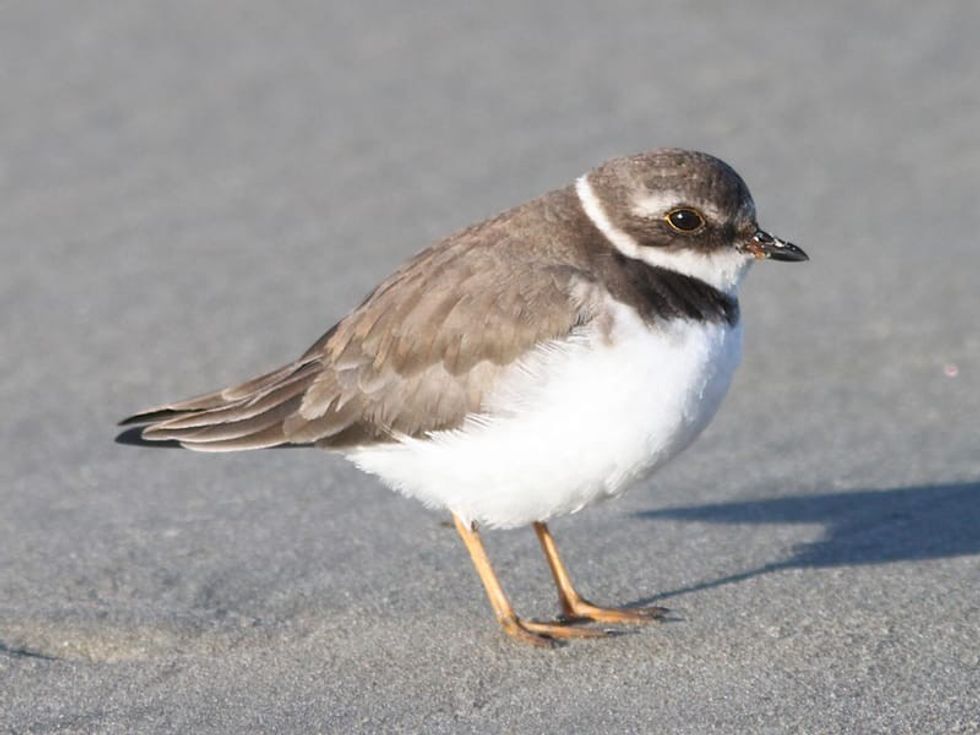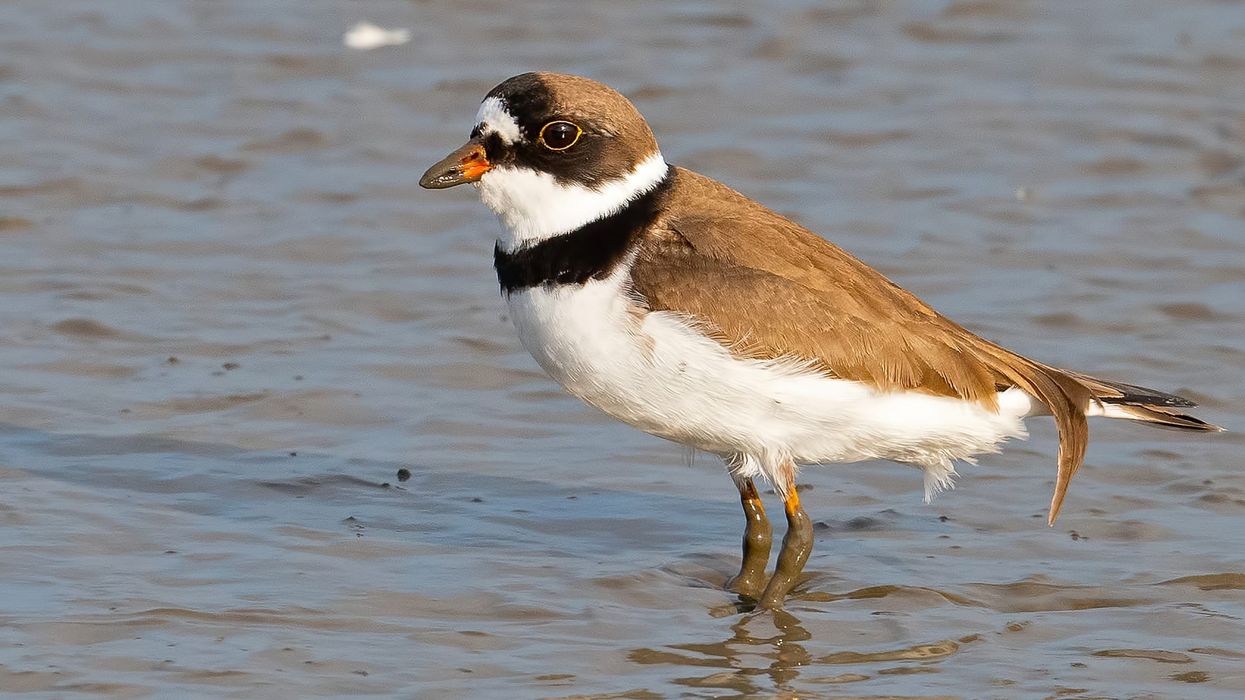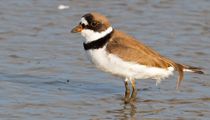Fun Semipalmated Plover Facts For Kids
The semipalmated plover is a North American bird that has dark earthy colored brown upperparts, white underparts, a dark face, collar, and temple, and a weak stripe in some cases seen over the eye. It has a brown-orange bill, orange legs and feet, and a brown tail with white edges.
Wings have white stripes noticeable in flight. It feeds on creepy crawlies, hatchlings, and different spineless creatures. 'Semi-palmated' means wading birds whose toes are webbed for only a part of their length.
The semipalmated plover is around 7 in (17.5 cm) long with a brown back and a white underside. It has a white neck and throat with a dark band around it and orange legs and feet.
Its dark bill has an orange band around it. The semipalmated plover has a dark bar on the highest point of its head, white eyebrows, and a white fix between its eyes.
If you like this article, full of information and captivating facts on semipalmated plover, check out our other articles on Egyptian plover and piping plover!
Semipalmated Plover Interesting Facts
What type of animal is a semipalmated plover?
Semipalmated plover (Charadrius semipalmatus) is a North American bird species belonging to the family Charadriidae bird guide. It is pretty popular in South America, the Arctic, and sub-Arctic North America, and it is also known for its use in the various colors of bird guides.
What class of animal does a semipalmated plover belong to?
Semipalmated plover (Charadrius semipalmatus) is a type of bird from North America belonging to the Animalia kingdom, class birds.
How many semipalmated plovers are there in the world?
Semipalmated plover (Charadrius semipalmatus) is classified under the Least Concern category, meaning that the plovers of North America are still breeding in many parts of the world. Semipalmated plover is a North American bird that is found in abundance in and around South America, Arctic, and sub-Arctic North America.
Where does a semipalmated plover live?
For good spring places, these shorebirds of North America lean toward level, open coast zones on sandy or overgrown north landscape. They are found in habitats on north sandy and rocky coast shorelines, lush waterways, and lakes, wet meadows on decrepit croplands, high rough seashores, and coastal beaches during winter migration.
What is a semipalmated plover's habitat?
They have habitats for breeding and to nest in the range from the ocean level to 5003.2 ft (1525 m) above ocean level bird guide.
Semipalmated plover’s family habitats move across the range of southern and northern United States and will visit on lakeshores, lakes, coastal beaches, and ponds in its range map habitat. Their breeding habitats in the southern and northern, winter territories, and nests incorporate open regions close to water.
For example, mudflats, salt bogs, sandy and sloppy seashores, tidal ponds, salt lakes, peaceful lagoons, beachfront estuaries, lakes, and inlets as a habitat range during winter migration.
Who do semipalmated plovers live with?
During their breeding season, semipalmated plovers family fly in blended runs with different shorebirds near the ponds and coastal beaches range. These groups are regularly minimal yet may likewise be in looser request during the breeding season and during migration.
At elevated tide, these birds perch and rest in thick-runs vegetation mudflats breeding range territory.
Perching southern and north herds may contain up to 1,100 birds; however, they are generally a lot more modest in range. When scrounging, semipalmated plovers like to take care of without anyone else in their nest, running a couple of steps on-site and pursuing their dinners.
How long does a semipalmated plover live?
It is known that around 15% range of the populaces comprises five or six year old adults. The life expectancy of the semipalmated plovers family is regularly restricted by the parasites held in their bodies in each season range map.
Of the five shorebird species concentrated in Manitoba and Churchill, semipalmated plovers have the highest interior parasites being tainted mudflats season territory.
Other potential reasons for mortality are low temperatures during hatching and winter, which cause parents on site to relinquish eggs and leave them presented to the frigid temperatures. Birds that keep on hatching in this sort of climate range ordinarily experience the ill effects of low body loads.
How do they reproduce?
During their rearing season, semipalmated plovers (Charadrius semipalmatus) are socially monogamous birds among their sexes. The parents pair up in their favorite places.
The males show up at their nesting grounds and play out a rippling romance flight joined by presentation calls.
This particular, moderate fold, profound wing-beat flight happens over 164 ft (50 m) over the nesting ground and serves to portray the limits of the male's region just as to draw in females.
On the breeding grounds, the male at that point spreads and pushes down his tail feathers, somewhat opens his wings, and puffs his plumes while consistently calling.
When the female has picked a male's area nest, the male follows the female, shielding her and the domain among the sexes. The male showcases undermining conduct to other male birds by advancing toward them with his head down and wings held marginally out from his body migration.
The male meets the female with, to some degree, violent conduct, in which he wastes time positioned and fans while making a 'chuttering' vocalization.
This forceful conduct decays as the romance continues in their nest and breeding grounds.
The male makes scratches on the nesting ground with his feet, and the female will help. While sitting in this new scratch, the female may likewise play out a tail-fanning show, demonstrating her choice to pick her mate and settle an area.
What is their conservation status?
Semipalmated plovers are classified as of Least Concern by the IUCN Red List of Threatened Species. This indicates that the population of this plovers bird species is stable in its range map. Plovers are protected under the Endangered Species Act as of 1986.
Semipalmated Plover Fun Facts
What does semipalmated plover look like?

Semipalmated plovers grown-ups have dim earthy colored upperparts and white breast underparts in both reproducing and nonbreeding plumage. While in rearing plumage, males have a dark breast band, a brown over the eyes and across the forecrown, and a minor white fix simply over the bill.
Over the dark breast band, there is a band of white that additionally stretches out across the throat. They highlight short, dark-tipped, orange bills and orange legs. The female plumage is comparable, however, drabber in general.
Non-rearing plumage is very similar for males and females and is the same as reproducing plumage during migration. Striking contrasts incorporate a decrease of the dark 'cover' to encompass just the eyes and auriculars. It also has a restricted white supercilium that associates with the white fix over the bill and a more obscure bill.
Semipalmated plover chicks have hazier wool feathers on their heads and back status. Their forecrowns and wings are generally white, and their bills are practically all dark.
Their dark plumes breasts are dotted with dark spots, and their bosom groups are smaller than the adults. As they age, adolescent plovers look like grown-ups in non-reproducing plumage however have yellowish legs.
How cute are they?
This bird is considered charming because of its round head, petite body, and interest in all things, including people. The semipalmated plovers are a little plover with a short bill and yellow-orange legs.
It has earthy colored upperparts with white beneath and a solitary, dull bosom band. The bosom band, sides of the head, and forecrown are dark in reproducing grown-ups and earthy colored in non-rearing adults and adolescents.
How do they communicate?
Male semipalmated plover chicks call with different individuals from their group with their most regular migration call, which comprises a soft and clear whistle. A stimulated form of this type of migration call is utilized with the end goal of romance.
During romance, guys likewise perform 'butterfly flights', while breeding they gradually and purposely beat their wings, around their region.
These flights are utilized for pulling in female mates, but at the same time, they are being used to outline the limits of the male's region migration calls.
If there is a danger present at their breeding grounds, the male will accuse the object of his head down and wings marginally outwards. Guardians impart the presence of hunters to their young with loud, quick, and rehashed calls, which signal uneasiness or apprehension breeding.
How big is a semipalmated plover?
Plover semipalmated chicks species are a tiny, agreeable bird that has a short neck and small head, giving it a particular circular body shape. Its tail is long and tight.
Their length range is about 6.7-7.4 in (17-19 cm)
Their wingspan is 18.5-19.6 in (47-50 cm)
How fast can a semipalmated plover fly?
Not much information is available on the average flying speed of the semipalmated plover species, but these birds are not known to travel around a lot, and they are at their nest. They're about half the size of a great kiskadee.
How much does a semipalmated plover weigh?
Semipalmated Plover species usually weigh around 1.6-1.9 oz (48-55 g), as some birds are known to be heavier than others.
What are the male and female names of the species?
The males and females of the semipalmated plover species don't have separate names.
What would you call a baby semipalmated plover?
There is no specific name for baby semipalmated plovers. Baby plovers can't fly, they need to wait for six to seven weeks after hatching to fly.
What do they eat?
The eating regimen of the Charadrius semipalmatus family at their nest living close to the coast comprises benthic spineless creatures from freshwater and marine conditions. These incorporate the hatchlings of long-legged and seashore flies, polychaete worms, isopods, scavengers, decapods, vegetation, and copepods. They also burn through tiny mollusks, including gastropods and bivalves, exactly like snails.
Charadrius semipalmatus are all the more inland incline toward earthbound spineless creatures like mosquitoes, grasshoppers, insects of the variety Ochtebius, arachnids, and the hatchlings of officer flies and shore flies. Ashore, these deft feeders additionally feed on berries or seeds from prairies or developed fields.
Are they dangerous?
No, semipalmated plovers are never aggressive. They stay away from human beings and do not try to interact with them. They can sometimes get aggressive towards other semipalmated plovers.
Would they make a good pet?
No, semipalmated plovers don't make great pets as they are not suitable for domestication. They are wild young birds and keep making a lot of noise. Although they are petite and charming, these are wild birds. In many spots, it is unlawful for you to keep one as a pet.
Did you know...
Semipalmated Plovers young walk or run with their heads up, stopping to search for prey. They usually 'foot-mix', holding one foot forward and vibrating the substrate to make spineless creatures move and be identified.
They regularly run whenever upset; however, they are additionally quick, excellent fliers. Semipalmated plovers perch and fly in herds; however, they search independently. They are regional around settling and taking care of territories near the ponds.
The female lays three to four eggs in a downturn in the ground nest. In sandy territories near mudflats, the home is fixed with shell sections and stones. On the tundra, the house is restored with plants.
Both the male and female brood the eggs till they become young. The chicks bring forth in minimal under a month. They fledge in three to about a month in their nest.
Do plovers have webbed feet?
Semipalmated plovers are tiny shorebirds with toes or feet that are halfway webbed. They have dim earthy colored upper parts and white underparts.
Their temple and eyebrows are white, with the face and collar, which stretches out around the neck, dark in reproducing plumage in non-rearing grown-ups and adolescents. The size and state of this collar transform its shape contingent upon the bird's stance: if upstanding, the collar at the bosom shows up wide. Whenever slouched down, it is tight.
What is the difference between a plover and a sandpiper?
Sandpiper birds are a big group of shorebirds or waders. Most of these species of these birds eat little spineless creatures. Various size of beak empowers different species to take care of in a similar environment, especially on the coast.
Semipalmated plovers birds are a broadly conveyed gathering of swimming birds. In total there are around 40 species in the family of plovers. They are found all through the world and are portrayed by generally short bills.
Here at Kidadl, we have carefully created lots of interesting family-friendly animal facts for everyone to discover! Learn more about some other birds from our swallow facts and monk parakeet facts pages.
You can even occupy yourself at home by coloring in one of our Semipalmated Plover coloring pages.
We Want Your Photos!
More for You
See All
Bachelor of Arts and Law specializing in Political Science and Intellectual Property Rights

Anusuya MukherjeeBachelor of Arts and Law specializing in Political Science and Intellectual Property Rights
With a wealth of international experience spanning Europe, Africa, North America, and the Middle East, Anusuya brings a unique perspective to her work as a Content Assistant and Content Updating Coordinator. She holds a law degree from India and has practiced law in India and Kuwait. Anusuya is a fan of rap music and enjoys a good cup of coffee in her free time. Currently, she is working on her novel, "Mr. Ivory Merchant".
Disclaimer
1) Kidadl is independent and to make our service free to you the reader we are supported by advertising. We hope you love our recommendations for products and services! What we suggest is selected independently by the Kidadl team. If you purchase using the Buy Now button we may earn a small commission. This does not influence our choices. Prices are correct and items are available at the time the article was published but we cannot guarantee that on the time of reading. Please note that Kidadl is a participant in the Amazon Services LLC Associates Program, an affiliate advertising program designed to provide a means for sites to earn advertising fees by advertising and linking to Amazon. We also link to other websites, but are not responsible for their content.
2) At Kidadl, we strive to recommend the very best activities and events. We will always aim to give you accurate information at the date of publication - however, information does change, so it’s important you do your own research, double-check and make the decision that is right for your family. We recognise that not all activities and ideas are appropriate for all children and families or in all circumstances. Our recommended activities are based on age but these are a guide. We recommend that these ideas are used as inspiration, that ideas are undertaken with appropriate adult supervision, and that each adult uses their own discretion and knowledge of their children to consider the safety and suitability. Kidadl cannot accept liability for the execution of these ideas, and parental supervision is advised at all times, as safety is paramount. Anyone using the information provided by Kidadl does so at their own risk and we can not accept liability if things go wrong.
3) Because we are an educational resource, we have quotes and facts about a range of historical and modern figures. We do not endorse the actions of or rhetoric of all the people included in these collections, but we think they are important for growing minds to learn about under the guidance of parents or guardians.







